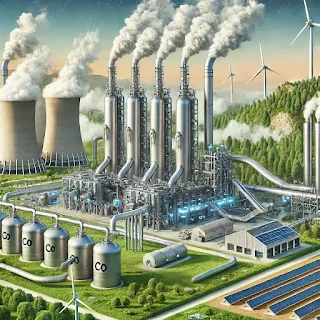Introduction
As the world battles climate change, carbon capture technology is emerging as a crucial tool in reducing greenhouse gas emissions. With rising carbon dioxide (CO₂) levels contributing to global warming, scientists and engineers are developing innovative ways to capture and store CO₂ from industrial processes and the atmosphere.
This article explores the science behind carbon capture, its benefits and challenges, real-world applications, and India’s policies supporting carbon capture initiatives.
What is Carbon Capture Technology?
Carbon capture technology refers to methods designed to trap CO₂ emissions before they enter the atmosphere or directly remove existing CO₂ from the air. This approach is essential in decarbonizing industries and mitigating climate change.
There are three primary types of carbon capture:
Pre-combustion Capture – Capturing CO₂ before fuel is burned, commonly used in power plants.
Post-combustion Capture – Extracting CO₂ from exhaust gases after fossil fuels are burned.
Direct Air Capture (DAC) – Pulling CO₂ directly from the atmosphere, offering potential for large-scale climate solutions.
How Does Carbon Capture Work?
The carbon capture process generally consists of three key stages.
Capture: CO₂ is separated from other gases during industrial processes or extracted from the air.
Transport: The captured CO₂ is compressed and transported via pipelines, ships, or trucks to a storage facility.
Storage or Utilization: CO₂ is either stored underground in geological formations (carbon sequestration) or repurposed for industrial uses (carbon utilization), such as making synthetic fuels or concrete.
The Importance of Carbon Capture in Climate Mitigation
Carbon capture technology is vital because:
It allows heavy industries (like cement, steel, and chemical manufacturing) to reduce emissions.
It can help countries achieve net-zero targets by offsetting emissions from hard-to-decarbonize sectors.
Direct Air Capture (DAC) can remove historical CO₂ emissions, reversing climate damage.
It enhances the feasibility of carbon markets and carbon credits, incentivizing businesses to adopt cleaner practices.
Challenges in Carbon Capture Technology
Despite its potential, this technology encounters multiple challenges:
High Costs – Carbon capture is expensive due to energy-intensive processes and infrastructure development.
Energy Demand – The technology requires significant energy, which must come from renewable sources to be truly sustainable.
Storage Risks – Long-term storage of CO₂ in underground reservoirs must be carefully monitored to prevent leaks.
Limited Adoption – Many industries are hesitant to invest in carbon capture due to high initial costs and lack of strong incentives.
Policy and Regulatory Barriers – Governments need clear policies and financial support to accelerate adoption.
Real-World Applications of Carbon Capture
Several countries and corporations are investing in carbon capture projects:
Norway’s Northern Lights Project: A large-scale carbon storage initiative storing CO₂ under the North Sea.
Climeworks (Switzerland): A leading company in Direct Air Capture technology, capturing CO₂ for use in carbon-neutral fuels.
Chevron and ExxonMobil: Oil giants investing in carbon capture to offset their emissions.
India’s Tata Steel: Successfully piloted carbon capture in steel manufacturing to reduce emissions.
India’s Policies on Carbon Capture and Climate Mitigation
India has committed to reducing its carbon footprint through several initiatives supporting carbon capture and carbon reduction:
1. National Action Plan on Climate Change (NAPCC)
India’s NAPCC includes eight missions, one of which focuses on sustainable energy and emissions reduction.
2. Carbon Credit Trading Scheme
The government has introduced carbon credit markets, allowing industries to earn credits for reducing emissions and trade them for financial benefits.
3. National Green Hydrogen Mission
Hydrogen fuel production is being promoted as an alternative to fossil fuels, reducing the need for carbon-intensive energy sources.
4. Public-Private Partnerships
Companies like Reliance Industries and Indian Oil Corporation are investing in carbon capture and storage (CCS) projects to align with India’s climate goals.
5. Afforestation and Carbon Sequestration Programs
India is expanding forest cover and launching carbon sequestration projects to naturally absorb CO₂ from the atmosphere.
The Future of Carbon Capture Technology
With continued research and investment, carbon capture technology is expected to become more affordable and scalable. Future advancements may include:
AI and Machine Learning: Optimizing carbon capture processes for greater efficiency.
Modular Carbon Capture Units: Smaller, scalable units that industries can deploy easily.
Carbon-to-Value Initiatives: Transforming captured CO₂ into valuable products, such as biofuels, chemicals, and building materials.
Conclusion
Carbon capture technology is a critical solution in the fight against climate change. While challenges remain, advancements in technology and supportive government policies are paving the way for widespread adoption. India’s commitment to carbon reduction, coupled with global innovations, will play a key role in making carbon capture a mainstream climate strategy.
Investing in carbon capture today will not only reduce emissions but also create a sustainable future for generations to come.
Courtesy: Internet

No comments:
Post a Comment